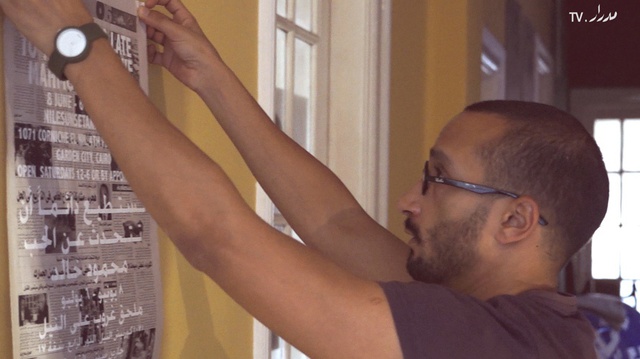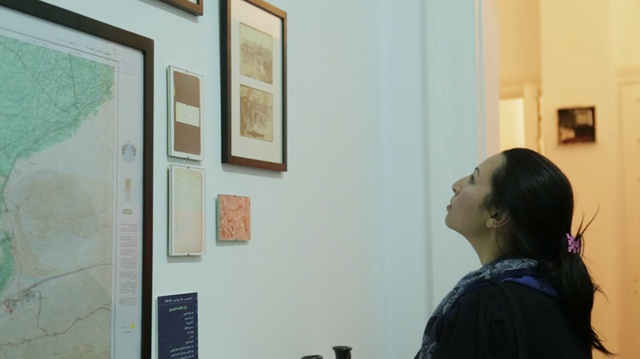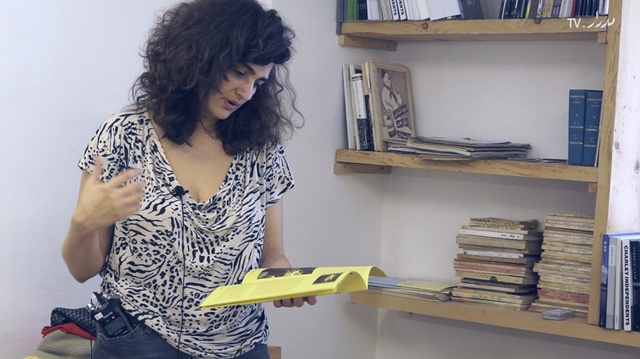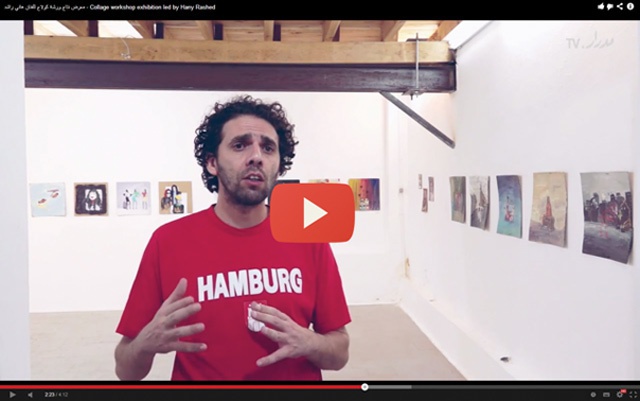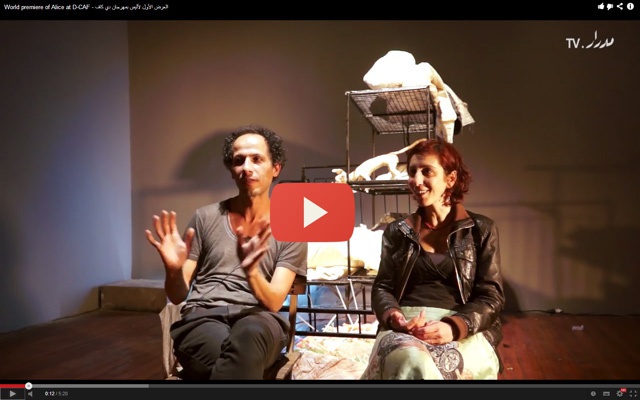Interviews
Video Channelling
Mai Elwakil in conversation with Daniella Rose King
Medrar.TV is a Cairo-based YouTube channel presenting digital content that documents contemporary visual art, sound and music events, exhibitions, talks, performances and interviews across Egypt and the Arabic-speaking world. In the interview that follows, Medrar.TV's co-founder and writer Mai Elwakil talks about the beginnings of Medrar.TV, the technological changes made to accommodate broader audiences and the founders' vision for enabling critical discussions and access to a plethora of contemporary cultural production. From its early documentary-style videos of 'Indicated by Signs', Cairene curator and now gallerist Aleya Hamza's book launch at the Goethe Institute in Cairo in 2010, to Sherif El Azma's 'Video By the Kilo' filmmaking workshop at Alexandria Contemporary Arts Forum in 2011, and the multi-venue retrospective exhibition 'Basiony 1978-2011' curated by artist Shady El Noshokaty in 2012, Elwakil explains the impulse behind Medrar.TV's drive to document, archive, animate and disseminate cultural information and documentation via an online platform.
Daniella Rose King: Why and how did Medrar.TV come about?
Mai Elwakil: Medrar.TV became fully operational in January 2013; that is when we received a grant from the Arab Digital Expression Foundation (ADEF) to buy proper filming and recording equipment and to pay our very small team of videographers and editors. But the project operated on a much smaller scale years before that. Our physical archive includes footage of exhibitions, talks, workshops and interviews that date as far back as 2005.
For instance, Medrar.TV co-founder, artist Mohamed Allam, documented the 2005 Form Through Light exhibition at the Palace of the Arts in Cairo. The footage shows the artworks as well as the artists installing them, and includes interviews where they talk about their interests. He did this with his personal camcorder because he was interested in discussing the artwork with fellow artists taking part in the exhibition. Medrar.TV did not exist at the time. But the interest in documenting works by contemporary artists was already there.
Allam did the same with other shows and performances, and in 2010 while on residency in Beirut, he devoted his three months there to meet with practicing artists, performers and musicians such as Raed Yassin, Gheith Al-Amine, Zeid Hamdan, Marwa Arsanios and Tarek Atoui. He introduced himself then as Medrar.TV, although the channel hadn't been launched. It was very informal. The meeting with Atoui for instance happened at a coffee shop.
Later in 2010, I met with Allam and he mentioned the project. I was immediately intrigued by the idea, as I often faced difficulties in finding information about art shows or events I had missed in Egypt and the wider region. What I could locate was often no more than a flyer or news clippings in English locked in the archives of art institutions. You had to contact each institution and explain who you are and what you are doing so that they would allow you in, and in many cases you'd be mostly trying to form an impression of the artwork based on the texts and flyers you found. For a general public, it's even more difficult, especially if one doesn't read English. Of course, things have changed a lot, with more artists and institutions trying to document their work and post it on social media or websites now. But that's quite a recent development.
DRK: Why in the form of a video channel? What is it about the medium? And have you considered utilizing other forms, for example radio, literature or even a programme?
ME: Medrar started as an artist collective. And I am essentially an art writer. We both realized the lack of critique in the local art scene at the time. But we also wanted to take a step back and focus on documentation. How could you encourage critique and research if the documentary basis you needed didn't exist? So we decided to focus on that. And because we are interested in contemporary art – much of which is time-based and involves moving images, live performances and interactive art – we felt that video would be the most suitable medium. We felt that video documentation would be the most faithful to the work, and equally important, it would be the most accessible.
Through the videos, we try show the actual work before it is framed with curatorial and interpretative texts so as to allow people to make up their own minds about it. Then they get to learn more about the artists' or curators' perspectives. We also felt that artists and the general public might be more inclined to watch a video and listen to someone talk about their interests and how they work rather than read a text about it. Our experience shows that you'd have to be really interested in the topic to spend time reading up on it. For the same reasons, we decided to move the channel from Vimeo to YouTube in 2012. We felt that, particularly in Egypt, people mostly watch YouTube and hence have a higher chance of stumbling upon the videos than in the case of Vimeo. We wanted to engage more people with the scene and allow them to see works that they might not have known about given the focus of mass media on mainstream and commercial art production.
As for your question about incorporating non-documentary forms into the channel, we had several thoughts on that. When we first started editing the videos, we wanted them to have an artistic edge – to lie somewhere between documentary and video art. But then we felt that we were interfering too much with the artwork we were meant to document. Plus, Medrar, the artist institution under which the TV channel operates, does have an ongoing program of art events and workshops.
DRK: What do you know about your audiences? Who are they, where are they located?
ME: Our first target group is the art community: artists, curators, historians, researchers and art students. We're also trying to gradually reach out to a broader audience and to a more general public. The art community, especially in Egypt, is following us closely. So far, the feedback we've been getting shows that it sees the channel as a valuable resource on the scene.
When we first started working, many artists would decline doing an interview as they were not comfortable being filmed and also because they were not sure in what context, shape or form they and their work would be presented. But this has changed and now artists and institutions contact us to come and document their projects. We think that we have managed to gain their trust; when they watched the edited videos of their work and that of others, they felt that it makes sense to present their work side by side with that of others in Egypt and around the Arab world. It helps draw an understanding of diverse scenes and practices.
We also have a strong following in Lebanon and Tunisia, places where we've filmed before. And of course, there are some followers from Palestine, UAE, Jordan, Morocco and Saudi Arabia. Since we started adding subtitles to the videos in early 2013, more people are following us from Europe, the USA and Southeast Asia. But for now, the majority is from Egypt, which is still very exciting. And perhaps some of the most rewarding responses are those which we get from people outside the art community; people we meet in social gatherings who, when we mention the channel, respond that they've watched our material, and they cite specific videos that have interested them. That means that we're gradually making a break through to a broader audience base.
DRK: A question on language. Much of the content is in Arabic, with some videos subtitled in English. How pressing a demand is subtitling or translating to Medrar.TV? And further to this, why translate?
ME: The main goal of the channel is to create a resource in Arabic. When we started working on the project, most of the information provided in exhibitions and performances was in English. The Arabic translation of curatorial and wall texts when it existed was more of an add-on, something made out of courtesy of being present in Cairo, where the vast majority of the population does not speak or read English. Even now, it is quite difficult to find specialized texts written or translated into Arabic.
Having the material in Arabic was important for accessibility and for making art-related terms in Arabic more common and familiar. Translators and writers are often faced with the challenge of finding an accurate equivalent to English art terminology, which is taken for granted all over the world. A few years back, curators were still debating how to describe their titles in Arabic. Of the various suggestions at the time were: monazem (organizer), modeer ma'ared (exhibition manager) and the like; the most commonly used one now is kayem (curator, or keeper), which outside the art world would not mean much. Now things are gradually changing with more people interested in writing and producing works in Arabic, although we have to admit that much of the terminology still sounds somewhat alien.
The decision to start adding English subtitles was for different reasons. Whereas we document a range of works, we have a special interest in experimental initiatives and early- to mid-career artists who might be overlooked by other media outlets, so we decided to add the English subtitles to make the archive accessible to people elsewhere who might not have a chance to learn about these works, artists and institutions. Now all videos, except the first eleven posted on the channel, are subtitled into English.
DRK: What is the channel's editorial policy in regards to deciding on which events, exhibitions and projects will be featured? And further, is there an editorial position that Medrar.TV takes? Is Medrar.TV concerned with archiving, collecting, documenting, positioning, and/or critique and analysis?
ME: To be honest, we are a very small team. We consult with one another on events and decide what to cover based on a perceived level of experimentation in the artwork, project or initiative. And we use the term artwork broadly to include experiments with sound, music, performance, video and film as well as the more common practices contained within the definition of the visual arts. We have a special interest in early- to mid-career artists who might not be in the spotlight. But we also cover established artists.
DRK: Can you elaborate on this idea of the 'perceived level of experimentation'?
ME: This 'perceived level of experimentation' might seem subjective and difficult to outline in terms of clear criteria. But what we can say is that we try to focus on artists and practices that are not very conventional and which we believe are important to document in the long run. We do not necessarily endorse or express an opinion on the final artwork. But we still think that the process and/or artist's perspective is worth highlighting. For instance we've documented and interviewed artists in 2010 and again in 2013. We think it's interesting and important to see how their work might have developed over time.
We are now moving more towards producing mini-profiles of artists and institutions where they'd get a chance to discuss their work over time, as well as their interests. We think it could help draw a more nuanced portrait of who they are. And we've started working on artist-to-artist series where we invite guest contributors to interview an artist when we feel this could lead to interesting discussions. This also gives more room for analysis and critique.
However, these new series will not replace the regular documentation, which we still value a lot. But it's another dimension that we think might enrich the experience of people who follow the channel and go through the archive.
DRK: Are there any future plans for Medrar.TV?
ME: One goal we've had since we started and are gradually working on is to find ways to post the complete interviews online as a searchable archive for those interested because we're limited on YouTube with viewers' relatively short concentration spans. So we'd like to have concise videos on YouTube, but also offer those interested access to the entire archive. Like we mentioned, we've started the artist-to-artist series, and of course we'd like to expand and be able to cover events and artists in other parts of the Arab world more regularly and form partnerships with initiatives or individuals sharing our interests abroad or even in Egypt. But perhaps the most basic and practical goal for us is to continue the project and make it sustainable in the long run because in addition to the individual videos, there's great value to the growing online archive as a whole. Unfortunately, free online platforms face many challenges on that front, particularly in the region. But that's a whole other discussion.
DRK: Can you talk about these general difficulties, as you perceive them, and do you see improvements being made in this regard?
ME: Most experimental publications and publishers now opt for building and using online platforms over printed materials, the reasons for which include: overcoming large bureaucratic and financial costs required in Egypt for setting up printed publications, avoiding possible censorship as online platforms continue to receive less attention from censors. But also the target readers and viewers of most of these platforms are under the age of 45. This target group has become less inclined to purchase printed magazines and newspapers and rely on social media networks such as Facebook and Twitter to find the content they're interested in whether by directly following the platforms' pages or through recommendations by friends and acquaintances on social media.
Online publishing platforms and projects do, however, face challenges such as the short concentration span of Internet and social media users in Egypt, who are flooded with hundreds of feeds every hour, which requires well-thought targeting plans to stand out. Another major challenge faced by most platforms is devising financially sustainable models, particularly since non-profit and experimental projects are cornered between limited advertising opportunities online and major sponsorships that could compromise a project's editorial independence.
DRK: You have produced a project for Ibraaz as part of Platform 007 – how does this project reflect both the issues Medrar.TV has faced, and the many approaches it is exploring?
ME: Our response to Ibraaz's Platform 007 on building art infrastructure and audience cultivation is a profile of Hashem L Kelesh. This Egyptian artist and musician is in his late 20s and has been using online technologies for the production and dissemination of most of his work. In his interview with Medrar.TV, he reflects on the local context in which artists operate, be it exhibition opportunities or art education systems. It is one of the first in-depth interviews we are publishing and seems highly relevant to the topic but also to the work of Medrar.TV as an online arts channel.
Watch Medrar.TV's project produced especially for Ibraaz Platform 007, here.
Mai Elwakil is a writer based in Cairo. She is the co-founder of the Arab contemporary arts channel Medrar.TV, and was the culture editor at the English language news website Egypt Independent until April 2013. She blogs at Arab Art Beat.
Medrar is an artist run institution in Cairo that supports the work of Egyptian artists locally and internationally through three main projects: The Cairo Video Festival – video art and experimental film, Open Lab Egypt and Medrar.TV. Medrar also has a regular program of exhibitions, talks, workshops and screenings.

